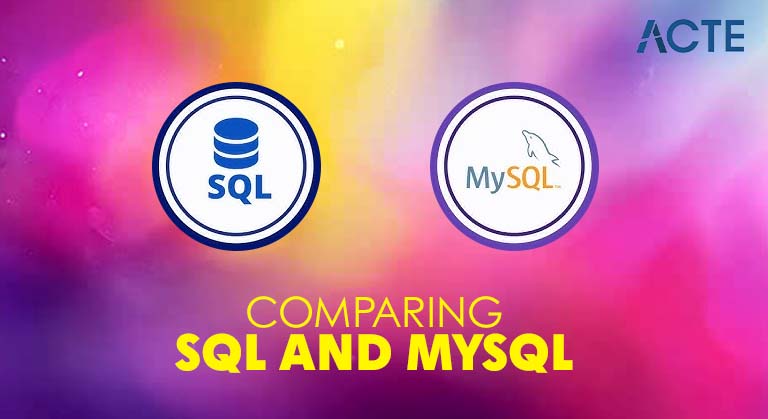
- Introduction
- What is SQL?
- What is MySQL?
- SQL Language vs MySQL Platform
- Command Syntax Comparison
- Server Features
- Performance Differences
- Security
- Community Support
- Use Cases
- Pros and Cons
- Final Verdict
Introduction
In the landscape of data management and digital applications, SQL and MySQL are two pivotal technologies that often spark confusion among newcomers. While SQL is a standardized language for querying and managing data in relational databases, MySQL is a popular relational database management system (RDBMS) that uses SQL as its query language. Database Training helps professionals grasp the distinctions and interconnections between key systems. Understanding these differences is critical for database developers, administrators, software engineers, and data professionals who need to work efficiently with structured data. This guide explores SQL and MySQL from fundamental definitions to technical comparisons, use cases, advantages, disadvantages, and performance aspects. By the end, you’ll gain clarity on how SQL serves as the language, while MySQL acts as the environment that executes SQL commands to manage large volumes of structured data.
What is SQL?
SQL (Structured Query Language) is the industry-standard language used to interact with relational databases. Developed initially by IBM in the early 1970s, SQL quickly became standardized by the American National Standards Institute (ANSI) and the International Organization for Standardization (ISO). SQL includes four main language functions that enable effective database management. The data definition language (DDL) offers basic structural commands such as creates, drops, and changes, which accurately define and modify the database schemes. Second Highest Salary In SQL is a common query used to rank employee earnings and analyze compensation structures. In addition, data manipulation language (DML) provides major commands such as selection, inserts, updates, and removal, allowing users to easily work and manage data records. Safety and access controls are handled through data control language (DCL), which uses grants to control the user permissions and cancel the command. Finally, the transaction control language (TCL) maintains data integrity using important commands such as commits, rollbacks, and savepoints, supports strong transaction management, and ensures reliability of database operations. SQL enables users to define relationships among data, query databases, aggregate and sort data, and perform analytics with accuracy and precision.
Interested in Obtaining Your Data Science Certificate? View The Data Science Online Training Offered By ACTE Right Now!
What is MySQL?
MySQL is a powerful open-source relational database management system (RDBMS) developed by MySQL AB and now maintained by Oracle Corporation. It is known for its performance, ease of use, reliability, and ability to handle massive databases. SQL includes four main language functions that enable effective database management. The data definition language (DDL) offers basic structural commands such as creates, drops, and changes, which accurately define and modify the database schemes.

In addition, data manipulation language (DML) provides major commands such as selection, inserts, updates, and removal, allowing users to easily work and manage data records. Safety and access controls are handled through data control language (DCL), which uses grants to control the user permissions and cancel the command. Finally, the transaction control language (TCL) maintains data integrity using important commands such as commits, rollbacks, and savepoints, supports strong transaction management, and ensures reliability of database operations. MySQL is often used in web development, especially in stacks like LAMP (Linux, Apache, MySQL, PHP/Python/Perl), and powers websites like Facebook, YouTube, and Twitter.
To Explore Data Science in Depth, Check Out Our Comprehensive Data Science Online Training To Gain Insights From Our Experts!
SQL Language vs MySQL Platform
| Aspect | SQL | MySQL |
|---|---|---|
| Definition | A language used to interact with RDBMS | A software system that implements RDBMS |
| Standard | ANSI/ISO standardized | Implementation of the SQL standard |
| Function | Executes commands to manage data | Stores, retrieves, and manipulates data |
| Independence | Platform-independent | Runs SQL within its own engine |
| Examples of Usage | SELECT, INSERT, DELETE | Web applications, reporting systems |
Command Syntax Comparison
Types Of SQL Indexes play a vital role in optimizing query performance across relational databases. SQL commands are largely consistent across database systems, but implementations such as MySQL can extend the syntax or introduce proprietary functionality.
- — Standard SQL
- SELECT name FROM employees;
- — MySQL supports this and more
- SELECT name FROM employees WHERE department = ‘Sales’;
- Auto-incrementing Primary Keys:
- — SQL Standard
- CREATE TABLE users (
- id INTEGER GENERATED ALWAYS AS IDENTITY,
- name VARCHAR(100)
- );
- — MySQL Syntax
- CREATE TABLE users (
- id INT AUTO_INCREMENT,
- name VARCHAR(100),
- PRIMARY KEY (id)
- );
- Limit and Pagination:
- — MySQL
- SELECT * FROM products LIMIT 10 OFFSET 20;
Command syntax comparison should summarize the key similarities and differences, evaluate the outcomes of the comparison, and emphasize the significance of these findings without introducing new information. The goal is to provide closure and leave the reader with a final, important thought.
Gain Your Master’s Certification in Data Science Training by Enrolling in Our Data Science Master Program Training Course Now!
Server Features
SQL doesn’t come with server capabilities, it’s a language. In contrast, MySQL includes extensive server features:
- Storage Engines: InnoDB, MyISAM, MEMORY, ARCHIVE
- Security: Access control lists, user roles
- Replication: Master-slave and master-master setups
- High Availability: Clustering and failover options
These features make MySQL a versatile platform for deploying enterprise-grade applications.

Performance Differences
SQL’s performance depends on how it is implemented by the database system. MySQL’s performance is optimized for speed and scalability, particularly for read-heavy workloads. Key MySQL optimizations include:
- Indexing: B-tree and full-text indexes enhance search efficiency.
- Query caching: Stores query results to speed up repeated execution.
- Optimizer hints: Help guide the query planner in handling complex queries.
- Connection pooling: Reuses database connections to reduce overhead.
- Efficient joins and subqueries: MySQL’s engine optimizes how multiple tables are queried.
For large-scale applications, performance tuning through schema design, indexing strategies, and query optimization are crucial.
Are You Preparing for Data Science Jobs? Check Out ACTE’s Data Science Interview Questions and Answers to Boost Your Preparation!
Security
Security isn’t directly managed by SQL as a language. MySQL, however, offers comprehensive security features: Our safety framework role-based access controls use strong user authentication. This method carefully manages and restricts the system. Database Training emphasizes the use of encryption protocols such as TLS/SSL for secure data transmission and storage. These protocols provide concrete protection against potential cyber threats, helping to safeguard organizational and user data within modern database environments. To reduce the risks of SQL injection, we use parameters that prevent harmful database changes. The enterprise version further improves security with detailed auditing features, allowing us to track and monitor system interactions closely. Following the best practices of the industry, we ensure least privileged principles, update regular systems, and keep a close watch on the access logs. This layered approach reflects our commitment to maintaining data security and high standards of organizational integrity.
Community Support
SQL enjoys universal documentation and support due to its standardized nature. MySQL, backed by Oracle and a robust open-source community, offers a vast array of forums, tutorials, and third-party tools. The MySQL ecosystem provides strong equipment and resources for database professionals and enthusiasts. MySQL provides a detailed graphical interface for the workpiece design, modeling, and management questions. PHPMYADMIN gives easy browser-based administration options. Developers can also use options such as Percona and MariaDB, which are better versions of the original database platform. Start a Career in Database Administration by building foundational skills in SQL, data modeling, and system architecture. For community support and knowledge sharing, Stack Overflow is an active question platform where professionals can share insight and solve problems. Whether you are a beginner or an experienced database administrator, the MySQL ecosystem ensures that support and learning resources are available, which helps users to improve their database management and development processes.
Use Cases
SQL and MySQL serve different use cases based on their design and capabilities:
- Used broadly for cross-platform data analytics.
- Facilitates data warehousing solutions.
- Powers ETL pipelines for data transformation and movement.
- Ideal for web development frameworks like WordPress and Drupal.
- Supports CRM systems such as SuiteCRM.
- Commonly used in SaaS platforms.
- Powers e-commerce backends for dynamic catalog and order management.
SQL:
MySQL:
MySQL is favored for real-time applications with low latency requirements and simple deployment needs.
Pros and Cons
- Universally adopted and well-documented.
- Platform-independent across diverse systems.
- Declarative and simple syntax enables efficient querying.
- Cannot be used alone requires a supporting DBMS.
- Syntax variations among vendors can affect portability.
- Free and open-source (community edition).
- Rapid query execution for read-heavy workloads.
- Easy to deploy and manage even for small teams.
- Vast community and tool support across ecosystems.
- Lacks advanced analytical capabilities (compared to PostgreSQL).
- Limited horizontal scaling in default setups.
- Features like partitioning are complex to implement.
SQL Pros:
SQL Cons:
MySQL Pros:
MySQL Cons:
Final Verdict
SQL and MySQL serve different yet complementary roles. SQL is essential for querying and manipulating relational data across platforms. MySQL provides a practical and efficient environment to execute those queries, store data, ensure integrity, and offer scalability. MySQL’s reliability, performance, and integration with other technologies make it ideal for small to medium-sized applications. For high-complexity enterprise applications, extended SQL-based systems like PostgreSQL or Oracle may be more suitable. When deciding between technologies, the choice is not SQL vs MySQL because you often need both. It’s about choosing the right database system that supports SQL and aligns with your project goals. The relationship between SQL and MySQL is one of language and implementation. SQL is the foundation upon which relational databases operate, providing a standard way to communicate with data. Database Training introduces MySQL as one of the many powerful platforms built to execute SQL commands efficiently. It supports structured query processing, making it a reliable choice for developers aiming to manage and manipulate relational data with precision. Together, they empower developers to store, retrieve, and manipulate data with precision, enabling everything from basic CRUD applications to enterprise-level business intelligence systems. For anyone working with databases, understanding both SQL and MySQL is essential to building scalable, secure, and performant solutions.


